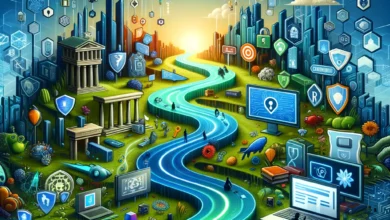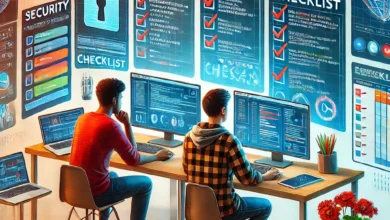Harnessing the Digital Renaissance: Bug Hunting in the Age of Automation
A Deep Dive into the Symbiotic Relationship Between Automated Tools and Human Intuition in Cybersecurity

Welcome, fellow enthusiasts and guardians of the digital realm! As we stand on the precipice of a new era in cybersecurity, we find ourselves intertwined in a dynamic dance of innovation and adaptation. The realm of bug hunting is no longer a niche pursuit of a select few but an essential aspect of the broader technological landscape. Today’s vulnerabilities are tomorrow’s front-page news, and it is in this intricate web of codes, algorithms, and systems that our journey unfolds.
Traditional methodologies in bug hunting, while still holding their value, are being seamlessly integrated with cutting-edge tools and techniques. The undeniable finesse of manual testing is beautifully complemented by the burgeoning world of automation, which has opened avenues previously thought impossible. These automated tools, once perceived merely as supporting actors, are now taking center stage, revolutionizing the way we approach vulnerability assessment.
Yet, as with any evolution, the introduction of automation comes with its unique challenges. Striking the right balance between human intuition and machine precision is an art that every modern bug hunter strives to master. This delicate equilibrium ensures that while we harness the immense power of automation, we never lose sight of the creative, unpredictable essence of the human mind.
In addition to these advancements, the digital age has bestowed upon us another invaluable gift: the democratization of education. Platforms like Udemy, Udacity, and Coursera, among others, have broken down geographical, financial, and institutional barriers. Now, anyone, anywhere, can access world-class resources, ensuring that the community of bug hunters grows not just in numbers but in diversity of thought, approach, and expertise.
As we delve into the depths of this article, we aim to provide insights into the transformative power of automation, the nuanced challenges it presents, and the boundless opportunities that online education platforms offer. Together, they shape the contemporary narrative of bug hunting, offering a glimpse into a future that is both challenging and exciting.
The Ongoing Search for the Ultimate Scanning Tool
Let’s heed an age-old saying: “Not all heroes wear capes.” In a similar vein, not all scanners are crafted for every mission. Every tool possesses its unique prowess, finely calibrated for particular tasks, settings, or vulnerabilities. The scanner perfect for one application might falter with another. Hence, our selection is often a dance between the nature of our target and our personal vulnerability-hunting predilections.
Renowned tools, such as OWASP ZAP, Nessus, Acunetix, and Burp Suite, have consistently demonstrated their reliability. Yet, the key to a successful expedition lies in mastering the nuanced strengths and limitations of each of these digital companions.
The Advantages of Embracing Automation
In the realm of cybersecurity, automation’s embrace promises both immediate and long-term dividends. As our digital world continues its relentless expansion, the tasks of scanning, analyzing, and assessing grow exponentially. Automation serves as a force multiplier in this vast arena, allowing for an efficient, scalable, and more rigorous approach to vulnerability detection. Below are some of the standout benefits of this merger of machine precision and human strategy.
- Velocity and Rigor: At the heart of automation lies its unparalleled speed. Vulnerability scans that might take humans days to complete can be accomplished within mere hours or even minutes with automated tools. This efficiency doesn’t just accelerate processes; it ensures that large codebases or complex web applications are thoroughly inspected within feasible timeframes.
- Example 1: Consider a sprawling e-commerce website with thousands of product listings, customer reviews, and transaction pages. Manual assessment of such a site would be time-consuming and potentially incomplete. However, an automated tool like Burp Suite can rapidly crawl the site, identifying common vulnerabilities like SQL injections or Cross-Site Scripting (XSS) in a fraction of the time.
- Example 2: In a Continuous Integration/Continuous Deployment (CI/CD) environment, code is constantly being integrated and deployed. Automated security tools can be incorporated into this pipeline to ensure every code push is automatically scanned, making sure vulnerabilities are caught in real-time rather than after deployment.
- Setting the Stage: Automation excels at preliminary groundwork. By automating the discovery of basic vulnerabilities, human experts can focus their efforts on more nuanced, complex threats. This results in a more streamlined and strategic vulnerability management process.
- Example: In the realm of web security, there are certain well-documented vulnerabilities categorized by OWASP as the ‘Top Ten‘. Many automated tools are adept at quickly identifying these vulnerabilities, allowing human experts to focus on more intricate, business-specific security loopholes.
- Steadfast Uniformity: One of automation’s crowning glories is its consistency. While human performance can fluctuate due to myriad factors—fatigue, oversight, or even simple human error—automated tools execute tasks with the same precision every single time.
- Example: Consider regression testing in software development, where previously developed and tested software is re-tested to ensure that changes haven’t introduced new flaws. Manual re-testing can be tedious and prone to oversights. On the other hand, automated tools can tirelessly and consistently execute these tests, ensuring that every facet of the software is evaluated without fail.
The Challenges Alongside the Rewards
While the advantages of automation in bug hunting are plentiful, it’s vital also to recognize and address the challenges inherent in relying heavily on machine-driven processes. Automation, in all its prowess, isn’t a panacea. Being aware of its limitations ensures that we use it judiciously, complementing, rather than overshadowing, human expertise.
- The Mirage of Infallibility: Automated tools, despite their rigorous algorithms, are not immune to errors. They can sometimes raise alarms where there aren’t any (false positives) or, worse, overlook genuine vulnerabilities (false negatives). Depending too much on automated results can lead to misplaced confidence or overlooked threats.
- Example 1: An automated scanner might flag an instance of user input as vulnerable to SQL injection based on certain heuristic checks. However, on manual examination, a security expert might realize that the input is properly sanitized and parameterized, making it safe.
- Example 2: Conversely, a tool might miss a business logic flaw that requires specific steps to exploit, which a manual tester with domain-specific knowledge could discern.
- Lack of Nuanced Understanding: While algorithms are adept at detecting patterns and anomalies, they often fall short in areas demanding contextual understanding or multifaceted reasoning. Some vulnerabilities are deeply entrenched in business logic or arise from intricate sequences of actions that automated tools might not be configured to detect.
- Example: An e-commerce site might have a logic flaw that allows users to apply multiple discount codes on a single product, resulting in prices dropping to zero. Such a flaw, rooted in business logic, might elude automated scanners but would be evident to a tester familiar with e-commerce operations.
- Over-reliance and Skill Erosion: A potential, albeit indirect, challenge is the possibility of skill erosion among bug hunters who over-rely on automation. By depending too heavily on tools, there’s a risk of becoming detached from the hands-on skills and intuition vital for deep-dive analyses and innovative exploit discoveries.
- Example: Consider a scenario where a bug bounty hunter leans predominantly on automated scanners for vulnerability detection. Over time, without consistent manual testing and exploration, the hunter might lose the edge in identifying novel vulnerabilities or devising unique exploitation techniques that seasoned experts often bring to the table.
Mastering the Dance with Automated Aids
- Know Your Companion: Dedicate time to delve deep into the mechanics of your chosen tool. Immerse yourself in its capabilities, specialties, and peculiarities.
- Trust with a Dash of Skepticism: Results derived from automation are preliminary stepping stones. The mantle of verification, contextualization, and, when required, exploitation falls upon our shoulders.
- Cooperative Strategy: Automation is a supplement, not a substitute. Let it enhance rather than eclipse your manual expertise.
Online Platforms: Fortifying Your Arsenal for the Future
In an ever-evolving digital realm, staying current is the key to excellence, and the significance of continuous learning cannot be overstated. With new vulnerabilities, attack vectors, and techniques emerging daily, bug hunters need an adaptive and forward-looking approach. This is where online educational platforms come into play, offering dynamic resources to bolster a hunter’s toolkit and prepare them for future challenges.
- Tailored Learning Pathways for Advanced Specializations: As cybersecurity domains expand and diversify, there’s a growing need for specialists. These platforms offer niche courses on emerging topics, ensuring that bug hunters are not only grounded in foundational knowledge but are also at the vanguard of new-age vulnerabilities and countermeasures.
- Example: With the rise of quantum computing, future cryptographic standards and their vulnerabilities will undergo transformation. Online courses could provide insights into quantum-resistant cryptographic techniques, prepping hunters for next-gen security challenges.
- Interactive Simulations and Real-World Scenarios: Modern online platforms are more than just repositories of lectures. They often integrate labs, simulations, and real-world scenarios, ensuring hands-on practice. This approach bridges the gap between theoretical knowledge and practical application, equipping bug hunters to tackle real-life challenges effectively.
- Example: Platforms like Hack The Box or TryHackMe, while primarily offering penetration testing environments, often partner with educational platforms to offer integrated courses. Learners can watch a lecture on Cross-Site Scripting (XSS) and immediately apply that knowledge in a simulated environment.
- Collaborative Learning and Global Networking: One of the inherent strengths of these platforms is the fostering of a global community. Learners from diverse backgrounds share insights, collaborate on projects, and even form partnerships. This melting pot of perspectives and expertise can provide novel solutions to complex problems and foster innovation in bug hunting techniques.
- Example: In a course forum, a student from Asia might share a unique vulnerability they discovered in local mobile applications. This could introduce European or American counterparts to new attack vectors or methodologies previously unexplored in their regions.
A Closer Examination of Digital Learning Platforms and Their Future Impact
Online educational platforms are not merely a transient trend; they represent the future of learning. Here’s how they are shaping the trajectory of bug hunting and cybersecurity at large:
- Democratizing Access to Elite Knowledge: Institutions and experts, previously exclusive or hard-to-reach, are now accessible to anyone with an internet connection. This democratization ensures that talent, regardless of geographical or economic constraints, can rise and contribute to global cybersecurity efforts.
- Adaptive and Rapidly Updating Curricula: Traditional educational setups often struggle to keep pace with the breakneck speed of cybersecurity developments. Online platforms, with their agile structure, can quickly incorporate new findings, threats, or techniques into their courses, ensuring learners are always abreast of the latest in the field.
- Augmented and Virtual Reality in Learning: The future of online education might not be restricted to screens. With advancements in AR and VR, immersive learning experiences could become the norm. For bug hunters, this could mean virtual “war rooms” where they collaboratively tackle a simulated cyber threat in real-time, offering an unparalleled depth of engagement. Example: Imagine a course where learners don VR headsets to enter a virtual corporate network. Here, they can “walk” through different servers, databases, and firewalls, identifying vulnerabilities and patching them in a fully immersive 3D environment.
- Personalized Learning Experiences: With the incorporation of artificial intelligence in education, future platforms could offer highly personalized learning paths. Based on a learner’s strengths, weaknesses, interests, and goals, AI-driven systems might curate content, recommend courses, or even devise personalized challenges to hone specific skills.
Charting the Path Ahead: Navigating the Future of Bug Hunting
The digital landscape, in its vastness and intricacy, is akin to an ever-shifting terrain. Within this realm, bug hunting stands out as one of the most exhilarating yet daunting adventures. But what does the future hold for those who tread this path?
Automation and online education platforms have undoubtedly paved new avenues for bug hunters, but these are just the beginning. The nature of cyberspace ensures that with every solution found, new challenges emerge. Hence, a proactive, anticipatory approach becomes vital for success.
The past decade witnessed the proliferation of IoT devices, leading to a surge in associated vulnerabilities. Similarly, the growing implementation of artificial intelligence and machine learning in various sectors presents another domain rife with potential security challenges. As we delve further into areas like quantum computing, blockchain, and augmented reality, the playground for bug hunters will expand exponentially.
But it’s not just the technological landscape that’s evolving. The very ethos of bug hunting is undergoing a transformation. With the increasing recognition of ethical hacking’s importance, there’s a surge in institutional support and organized frameworks. We’re transitioning from a scenario where hackers operated in shadows, often misunderstood and maligned, to a time where they’re celebrated as the guardians of cyberspace.
Corporate entities, too, are altering their approach. The concept of “security through obscurity” is becoming archaic. Instead, transparency and collaboration with the hacking community are being embraced. Bug bounty programs are now more than just PR exercises; they are integral components of comprehensive cybersecurity strategies. Organizations are not just acknowledging external input but are actively seeking it, understanding that the collective intelligence of the global hacker community far outstrips any internal team’s capabilities.
Education, especially through online platforms, plays a pivotal role in this evolving narrative. As we’ve discussed, platforms like Udemy, Udacity, and Coursera are bridging gaps, democratizing knowledge access, and fostering global collaborations. But their impact is deeper. They’re shaping a new generation of bug hunters – individuals who are not only technically adept but also ethically grounded and globally conscious. This holistic approach, where skill is harmoniously blended with integrity, will define the future of bug hunting.
The road ahead, undoubtedly, will have its share of challenges. New vulnerabilities, sophisticated attack vectors, and evolving technologies will constantly test the mettle of bug hunters. But equipped with the right tools, fortified by knowledge from global platforms, and driven by a collaborative spirit, the future seems not just promising but exhilarating.
Bug hunting, in essence, is more than just a technical endeavor; it’s a commitment to safeguarding the digital realm. As we advance, this responsibility grows, but so do the resources and community support. In this journey, every individual effort contributes to a collective goal: a more secure, resilient, and trustworthy digital world. And in this endeavor, remember, every challenge surmounted, every vulnerability patched, and every bug hunted down makes the interconnected web of cyberspace a little safer for all.






